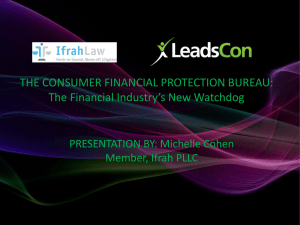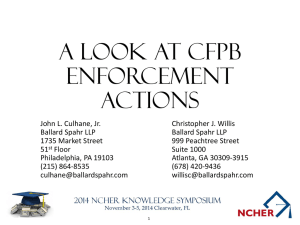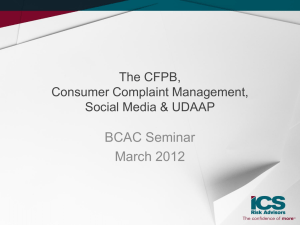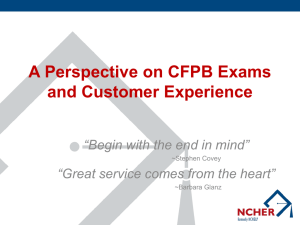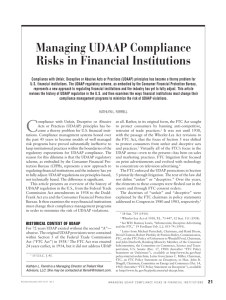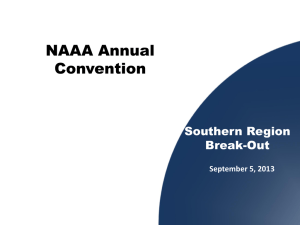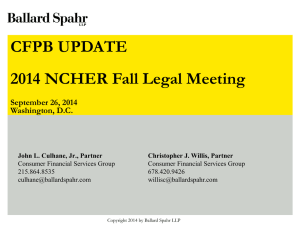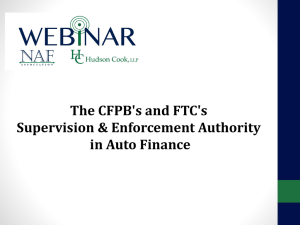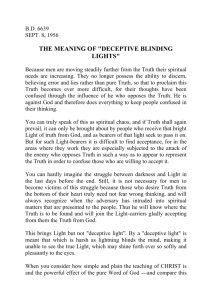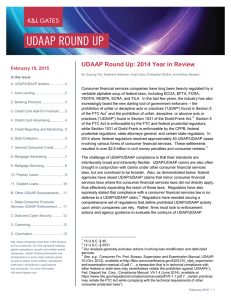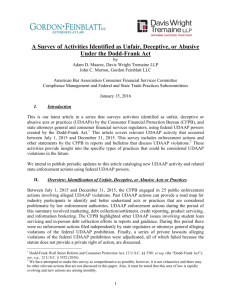A SURVEY OF UNFAIR, DECEPTIVE, AND ABUSIVE PRACTICES
advertisement
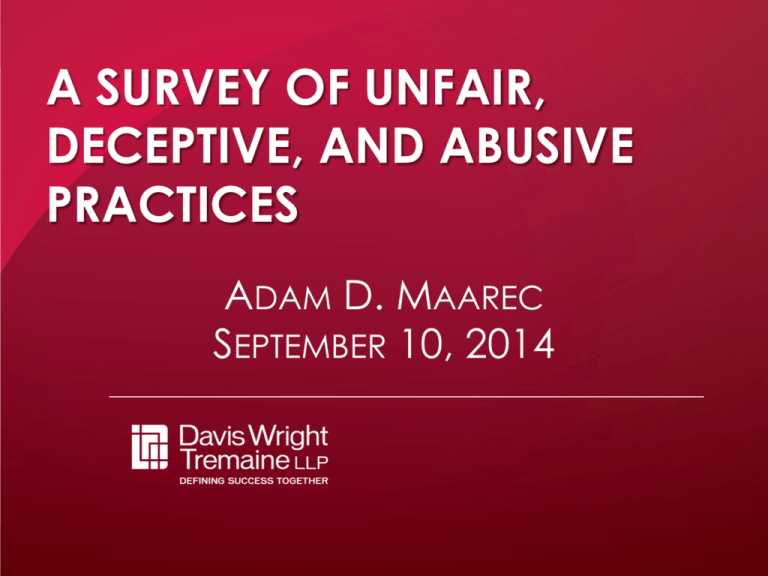
A SURVEY OF UNFAIR, DECEPTIVE, AND ABUSIVE PRACTICES ADAM D. MAAREC SEPTEMBER 10, 2014 OVERVIEW COMPLIANCE & UDAAP ENFORCEMENT 2 OVERVIEW 1. BACKGROUND 3 OVERVIEW 2. IDENTIFYING UDAAP: ENFORCEMENT 4 OVERVIEW 3. IDENTIFYING UDAAP: BULLETINS 5 OVERVIEW 4. WHAT’S NEXT? 6 BACKGROUND Section 5 of the FTC prohibits UDAP – Wheeler-Lea Act of 1938 expanded FTC powers from preventing unfair competition to UDAP • FTC enforces against many non-banks • Banking regulators enforce against banks State authorities enforce state UDAP statutes Dodd-Frank changes regulatory focus 7 THE CATALYST Democracy Journal, Summer 2007 8 CFPB’S MISSION: PROTECT AMERICANS EDUCATE ENFORCE STUDY 9 CFPB’S ENFORCEMENT POWERS Transferred laws: - TILA, ECOA, FDCPA, Privacy in GLBA, RESPA, and others 12 U.S.C. 5481(12) “enumerated consumer laws” New authority: - Power to prohibit unfair, deceptive, and abusive acts and practices Dodd-Frank Act § 1031 (codified at 12 U.S.C. §§ 5531(a); 5536(a)(1)) 10 WHO IS SETTING UDAAP PRECEDENT? 11 COP ON THE BEAT Warren’s charge to stop “tricks and traps” CFPB’s enforcement action count (complaints and settlements): – 2012 – 6 – 2013 – 20 – 2014 (first 6 months) - 7 UDAAP-based actions – 16 in 2012 & 2013 • 9 were settlements – 3 in first half of 2014 • 2 were settlements 12 WHAT’S THE BIG DEAL? Malleable concepts that depend on facts and circumstances – UDAAP-based rulemakings have been limited • Remedies to enforce credit obligations • Telemarketing – Know it when you see it UDAAP = Enforcement – Cases set precedent 13 WHAT’S THE BIG DEAL? Body of CFPB settlements – looks and feels like common law BUT: – Lacks checks and balances – No judge – Subjective interpretations with little rationale – No admissions by parties – New policy but no notice & comment 14 STATES STEP IN States are using federal UDAAP powers 15 IDENTIFYING UDAAP 16 “UNFAIR” PRACTICES - Defined by Dodd-Frank Act An act or practice that: “[1]causes or is likely to cause substantial injury to consumers [2] which is not reasonably avoidable by consumers [and [3] the] injury is not outweighed by countervailing benefits to consumers or to competition.” 12 USC § 5531(c)(1) See also FTC Policy Statement on Unfairness (December 17, 1980) 17 EXAMPLE: UNFAIRNESS IN PRODUCT EXECUTION CREDIT MONITORING PRODUCT Consumer purchases monitoring of credit report information at three credit bureaus from card issuer Card issuer does not track activity at one or more credit bureaus – Customers never notified – Customers pay full price for the product without receiving full benefits Injury, unavoidable, no countervailing benefits 18 “DECEPTIVE” PRACTICES - Defined in the CFPB’s Exam Manual a material representation, omission, act or practice that misleads or is likely to mislead a consumer, provided the consumer’s interpretation is reasonable under the circumstances CFPB Examination Manual V.2, UDAAP 5 (October 2012) See also FTC Policy Statement on Deception (October 14, 1983) 19 EXAMPLE: DECEPTIVE TELEMARKETING SALES INSERT VIDEO CLIP 20 EXAMPLE: DECEPTIVE TELEMARKETING SALES DEBT PROTECTION PRODUCTS Misrepresentations of materials terms that influence purchase decision – Mischaracterization of benefits • Death benefit – $25,000 vs. amounts outstanding up to $25,000 • Duration – 12 or 24 months of benefits vs. three – Inadequate consent: enrollment before key terms disclosed; mischaracterized free look periods – Claims process mischaracterized 21 OTHER EXAMPLES OF UNFAIR OR DECEPTIVE PRACTICES Misleading cost or price claims Omitting material limitations Failing to provide promised services Bait and switch ~~~~~~~~~~~~~~~~~~~~~~~~~~~~~~~~~~~~~~~~ Offering a service that is not actually available Selling a product unfit for its purpose Unfair or Deceptive Acts or Practices by State-Chartered Banks, FDIC FIL 2004 22 “ABUSIVE” PRACTICES Defined by Dodd-Frank Act An act or practice that: “[1] materially interferes with the ability of a consumer to understand a term or condition of a consumer financial product or service;” OR 23 “ABUSIVE” PRACTICES An act or practice that: “[2] takes unreasonable advantage of [either]: – “a lack of understanding on the part of the consumer of the material risks, costs, or conditions of the product or service; – “the inability of the consumer to protect the interests of the consumer in selecting or using a consumer financial product or service; or – “the reasonable reliance by the consumer on a covered person [such as a bank or other financial institution] to act in the interests of the consumer.” 12 USC § 5531(d) 24 EXAMPLE: ABUSIVE ACTS IN DEBT-RELIEF DEBT-RELIEF SERVICES Consumer pays fee for debt-relief services after being told debt could be settled in 3-6 months Abusive practice: to knowingly enroll consumers whose financial conditions made it highly unlikely that they could complete the program – Inadequate income to support repayment 25 EXAMPLE: ABUSIVE ACTS IN DEBT COLLECTION DEBT-COLLECTION On-line payday loan agreements that were: – “subject solely to the exclusive laws and jurisdiction of the Cheyenne River Sioux Tribe, Cheyenne River Indian Reservation…” CFPB said loans were void in some states due to licensing or usury violations Abusive practice: collecting on loans when taking “unreasonable advantage of consumers’ lack of understanding about the impact of applicable state laws on the parties’ rights and obligations” 26 UNIVERSAL PROBLEMS INADEQUATE COMPLIANCE MANAGEMENT SYSTEMS Failure to prevent, identify, and correct problems 27 CFPB BULLETINS ADDRESSING UDAAP Prohibition of UDAAP in the Collection of Consumer Debts – – – – – – Collecting unauthorized debts, i.e. late fees Untimely posting payments and charging late fees Illegally taking possession of property Revealing consumer debt to employers or co-workers Falsely representing debt amount or status Misrepresentations regarding: • Source of communications – attorney or a government agency • Reporting to credit agencies • Waiver or forgiveness offers CFPB Bulletin 2013-07 28 ADDITIONAL UDAAP GUIDANCE Marketing of Credit Card Promotional APR Offers – 0% balance transfer offers • If a promotional balance transfer is not paid in full, consumer will lose grace period on future purchases and pay interest even if new purchase balance is paid in full – Deception: Misrepresenting the true cost of promotional interest rate offers • Transaction fee in Reg Z disclosure is the only fee • Promotional rate is the only rate charged – Failure to disclose contingent costs – Abusive: Taking unreasonable advantage of consumers by failing to adequate disclose conditions & exploiting this lack of understanding – Above & Beyond Reg Z – Requires additional discloses re: effect of promotional APR offers on grace period for new purchases CFPB Bulletin 2014-02 29 NO SAFE HARBORS No clear rules of the road Banks pull back, exit amid uncertainty Safety needed to return 30 PREVENTING UDAAP VIOLATIONS TO ENSURE COMPLIANCE: 1) TRACK UDAAP 2) ROBUST CMS 31 SURVEY OF UDAAP ACTIONS 32 VISIT OUR BLOG 33 Disclaimer This presentation is a publication of Davis Wright Tremaine LLP. Our purpose in making this presentation is to inform our clients and friends of recent legal developments. It is not intended, nor should it be used, as a substitute for specific legal advice as legal counsel may only be given in response to inquiries regarding particular situations. Attorney advertising. Davis Wright Tremaine and the D logo are registered trademarks of Davis Wright Tremaine LLP. © 2014 Davis Wright Tremaine LLP. 34
